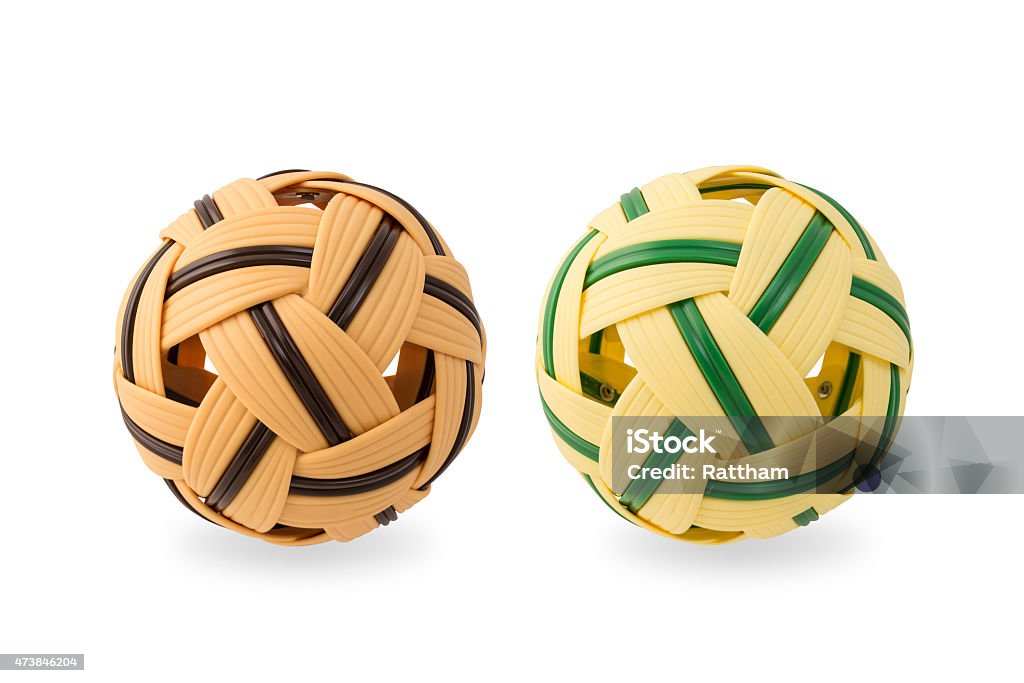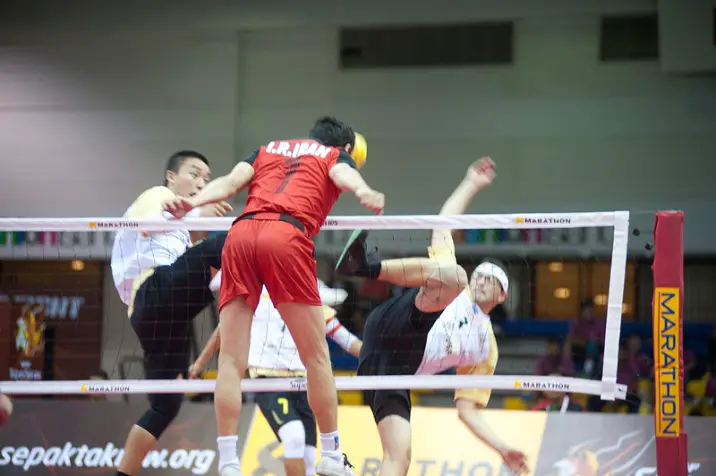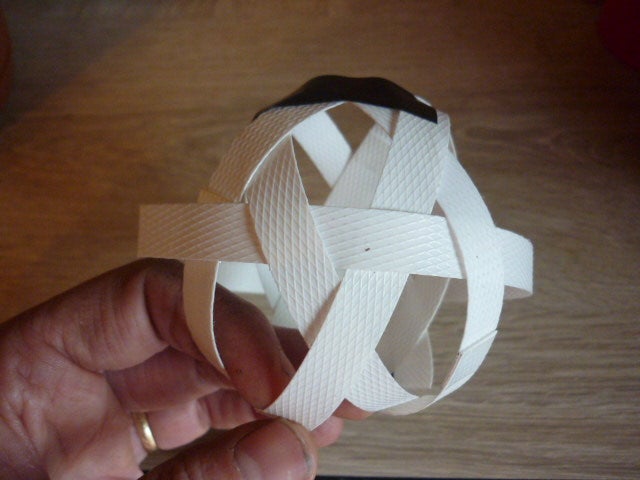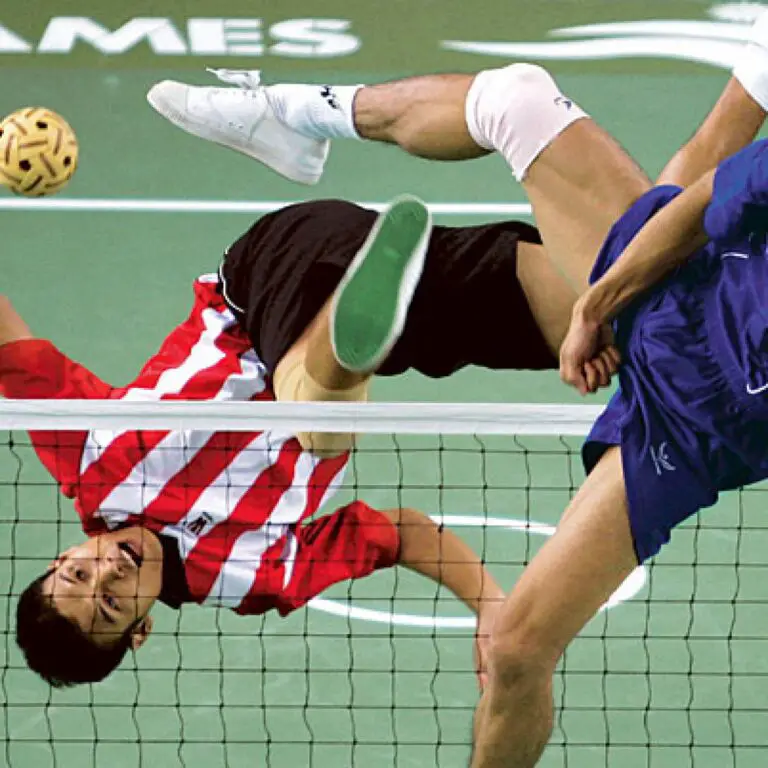What is a Sepak Takraw Ball Made Of? Discover the Materials!
( If you purchase through our sponsored links, we may receive a small commission at no extra cost to you )
A Sepak Takraw ball is typically made of synthetic fiber or nylon strands woven into a hard, lightweight, and durable spherical shape. It is designed to withstand the high-impact kicks and fast-paced movements of the game.
Sepak Takraw, also known as kick volleyball, is a popular sport in Southeast Asia that combines elements of soccer and volleyball. The ball used in Sepak Takraw is unique, as it is not made of leather like a traditional soccer ball or rubber like a volleyball.
Instead, it is crafted from synthetic fibers or nylon, allowing for greater durability and resilience during intense gameplay. The use of these materials ensures that the ball can withstand the powerful kicks and acrobatic maneuvers performed by players without losing its shape or integrity. Understanding the composition of the Sepak Takraw ball is essential for players and enthusiasts to appreciate the technical aspects of the sport.
The Origin Of Sepak Takraw
The origin of Sepak Takraw dates back to ancient Southeast Asia, where it was traditionally played as a form of entertainment and a show of skill. It is believed to have its roots in the countries of Malaysia, Thailand, and Indonesia, where the game is deeply embedded in the culture and heritage of the region. The game has evolved over time and has become popular worldwide, captivating people with its unique blend of athleticism and teamwork. Understanding the history and cultural significance of Sepak Takraw can provide valuable insights into the sport’s essence and its role in Southeast Asian society.
History Of Sepak Takraw
Sepak Takraw, often referred to as “kick volleyball,” has a rich history dating back hundreds of years. It is believed to have originated in the 15th century, with references to similar games found in historical texts and artifacts from the region. The game has since evolved into its modern form, with standardized rules and international competitions attracting participants and spectators from around the world.
Southeast Asian Roots
The roots of Sepak Takraw can be traced back to the indigenous cultures of Southeast Asia, where the game holds a special place in the hearts of the local population. Countries such as Malaysia, Thailand, and Indonesia have longstanding traditions of playing Sepak Takraw, with each nation adding its unique flair and variations to the game. The sport has become an integral part of the region’s sporting heritage and continues to play a significant role in local festivals and community events.
Cultural Significance
Sepak Takraw is deeply ingrained in the cultural fabric of Southeast Asia, symbolizing the spirit of athleticism, sportsmanship, and camaraderie. The game is not only an athletic pursuit but also a reflection of the region’s heritage and traditions. It serves as a platform for communities to come together, celebrate their shared history, and showcase their skills in a spirited competition. The cultural significance of Sepak Takraw extends beyond the boundaries of the game, influencing art, music, and other aspects of Southeast Asian society.
Evolution Of Sepak Takraw Ball Materials
In the sport of Sepak Takraw, the ball is a crucial element that has undergone a significant evolution in terms of materials used for its construction. The Evolution of Sepak Takraw Ball Materials reflects the traditional and historical aspects alongside modern innovations which have been influenced by technological advances.
Traditional Materials
Rattan and Woven Grass were extensively used in the historical construction process of Sepak Takraw balls. These materials were favored for their flexibility, durability, and ability to withstand the impact of the game. The use of these natural materials was rooted in traditional craftsmanship, imparting authenticity to the sport’s equipment.
Historical Construction Process
The historical construction process of Sepak Takraw balls involved skilled artisans weaving rattan and grass into a spherical shape, meticulously ensuring the tightness of the weave to achieve the requisite bounce and durability. This labor-intensive process highlighted the artisanal craftsmanship and artistry associated with the creation of these traditional balls.
Modern Innovations
Modern innovations in Sepak Takraw ball materials have seen a shift towards the use of synthetic fibers and plastics. These materials offer enhanced durability, consistency, and performance, catering to the evolving demands of the sport. The incorporation of modern materials has also facilitated standardization in manufacturing, ensuring uniformity and quality across the production of Sepak Takraw balls.
Synthetic Fibers And Plastics
The adoption of synthetic fibers and plastics has revolutionized the construction of Sepak Takraw balls, providing players with enhanced playability and reliability. These modern materials offer greater resilience to wear and tear, contributing to longer-lasting and more consistent performance during gameplay.
The Impact of technological advances has been profound, leading to the refinement and evolution of Sepak Takraw ball materials. The seamless combination of traditional craftsmanship and modern innovation has elevated the sport’s equipment, aligning it with the demands of contemporary competition while preserving its cultural legacy.
The Anatomy Of A Sepak Takraw Ball
When it comes to the sport of Sepak Takraw, the Sepak Takraw ball is the heart of the game. Understanding the anatomy of this specialized ball sheds light on the skill and precision required to play the sport. From the core components to the outer shell, every aspect of the Sepak Takraw ball is meticulously designed to ensure durability and optimal performance.
Core Components
The inner core construction and the materials used play a crucial role in determining the weight, density, and overall performance of the Sepak Takraw ball.
Inner Core Construction
- The inner core of a Sepak Takraw ball is typically made of synthetic fibers or rubber.
- These materials are carefully woven or layered to achieve the desired weight and density.
- Optimal inner core construction ensures consistent and predictable ball behavior during gameplay.
Weight And Density Considerations
- The weight and density of the inner core are critical for the ball’s responsiveness and playability.
- Well-balanced weight and density contribute to the ball’s ability to maintain a stable trajectory and ease of handling for players.
Outer Shell
The outer shell of the Sepak Takraw ball serves as a protective layer while also influencing its durability and performance characteristics.
Synthetic Cover Materials
- High-quality synthetic materials, such as nylon or polyurethane, are commonly used to create the outer shell of the Sepak Takraw ball.
- These materials are selected for their durability, resilience, and resistance to abrasion during intense gameplay.
Durability And Performance Factors
- The durability of the outer shell directly impacts the longevity of the ball, ensuring it can withstand the rigors of competitive play.
- Performance factors, including the grip and aerodynamic properties of the outer shell, contribute to precise ball control and striking techniques.
Impact Of Material Choices On Gameplay
When it comes to Sepak Takraw, the material of the ball plays a pivotal role in determining the overall gameplay experience. From ball control and maneuverability to influencing game strategies, the choice of materials significantly impacts the safety, longevity, and player protection considerations as well as the maintenance and lifespan of the ball.
Performance Characteristics
The performance of a Sepak Takraw ball is heavily influenced by its material composition. Different materials offer varying levels of bounce, weight, and responsiveness, which directly affect gameplay.
Ball Control And Maneuverability
The weight, texture, and elasticity of the ball material greatly influence a player’s ability to control and maneuver the ball with precision. Smoother surfaces might facilitate easier spins and handling, while lighter materials could enhance agility during gameplay.
Influence On Game Strategies
The material choice can also impact game strategies, as the ball’s behavior and movement in response to different playing styles and techniques are determined by its composition.
Safety And Longevity
Concerns about safety and ball longevity are directly tied to the choice of materials. Durability, resistance to wear and tear, and the potential for injury prevention greatly depend on the construction of the ball.
Player Protection Considerations
The material composition of the ball is an essential factor in ensuring player safety during the game. Padded, shock-absorbing materials can reduce the risk of injury and provide a safer playing experience.
Maintenance And Lifespan Of The Ball
The type of material used in the ball directly impacts its maintenance requirements and overall lifespan. Certain materials may require specific cleaning methods or exhibit prolonged durability, contributing to an extended ball lifespan.
Environmental And Sustainability Considerations
When it comes to the manufacture of Sepak Takraw balls, environmental and sustainability considerations are of paramount importance. The materials used in the production of these balls have far-reaching impacts, and the industry is increasingly focusing on ensuring eco-friendly practices and sustainable initiatives.
Traditional Vs. Modern Material Impact
The choice of materials used in Sepak Takraw ball production has a substantial effect on the environment. Traditional balls were originally made from natural materials such as rattan, which had minimal ecological impact due to their organic sourcing and biodegradability. However, the shift towards modern synthetic materials, including polyethylene and synthetic rubber, has raised concerns about the environmental repercussions of production, disposal, and non-biodegradability.
Ecological Implications
The ecological implications of using non-biodegradable synthetic materials for Sepak Takraw balls are significant. These materials contribute to environmental pollution and can have long-term effects on ecosystems. With the increasing use of synthetic materials, there is a growing need to address the ecological implications and find sustainable alternatives.
Sustainability Initiatives Within Sepak Takraw Industry
The Sepak Takraw industry is actively engaging in sustainable initiatives to mitigate the environmental impact of its manufacturing processes. One such initiative involves researching and developing alternative materials that are eco-friendly and biodegradable, thus reducing the ecological footprint of the balls. Furthermore, there is a focus on implementing efficient waste management and recycling programs to minimize the environmental impact of production and disposal.
In addition, manufacturers are exploring eco-friendly production methods, such as using renewable energy sources and reducing the use of harmful chemicals, to align with sustainable practices and reduce their carbon footprint.

Credit: www.istockphoto.com
Frequently Asked Questions For What Is A Sepak Takraw Ball Made Of?
How To Make A Sepak Takraw Ball?
To make a sepak takraw ball, start by cutting plastic straws into small pieces. Then weave the pieces into a spherical shape using rattan or plastic cord. Finally, trim the excess and tighten the weave for a firm and durable ball.
How Many Holes Are There In A Sepak Takraw Ball?
A sepak takraw ball has 12 holes, six on each hemisphere, facilitating airflow to improve control and accuracy.
What Makes Sepak Takraw Different From Other Sports?
Sepak Takraw differs from other sports due to its use of feet, head, knees, and chest to touch the ball. It requires agility, flexibility, and coordination, making it a unique and fast-paced game. The game demands a high level of skill and athleticism from its players.
What Is The English Of Sepak Takraw?
The English name for Sepak Takraw is “kick volleyball. ” It is a popular sport in Southeast Asia.
Conclusion
The Sepak Takraw ball is traditionally made from rattan or synthetic fibers. These materials contribute to its durability and flexibility, crucial for the fast-paced game. The intricate weaving process ensures high quality and performance, making the Sepak Takraw ball an essential part of this popular sport.
Understanding its construction adds depth to the appreciation of this unique game.




